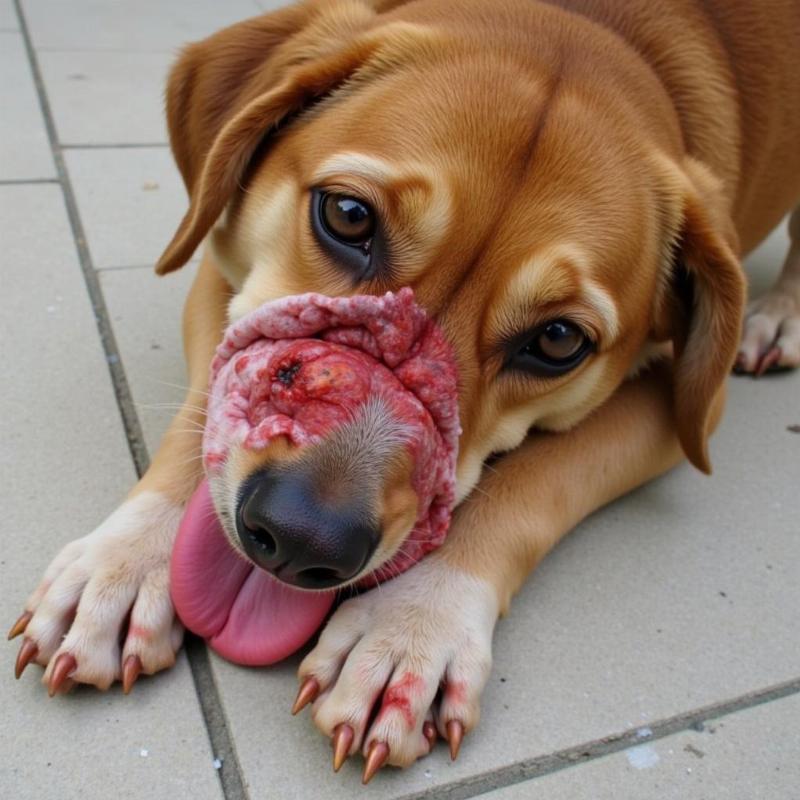Understanding your dog’s heat cycle is a crucial part of responsible pet ownership in the US. Whether you’re planning to breed your dog or simply want to be prepared for the changes a heat cycle brings, this comprehensive guide will provide valuable insights into the process, dispelling common myths and offering practical advice for navigating this important stage in your dog’s life. We’ll cover everything from recognizing the signs of heat to managing your dog’s behavior and hygiene.
It’s important to note that inducing a heat cycle in a dog artificially is neither recommended nor possible. A dog’s reproductive cycle is naturally regulated by hormones, and attempting to manipulate it can be detrimental to her health. Instead of searching for “how to bring a dog into heat,” focus on understanding the natural process and preparing yourself for when it occurs. This article will guide you through every step, providing you with the knowledge you need to care for your dog responsibly during her heat cycle.
Understanding the Canine Heat Cycle
The canine heat cycle, also known as estrus, is a complex process marking a female dog’s fertile period. It typically occurs twice a year, although this can vary depending on breed and individual dog. The cycle is divided into four stages: proestrus, estrus, diestrus, and anestrus. Recognizing the signs of each stage is key to managing your dog’s health and behavior.
Proestrus: The First Signs
Proestrus is the first stage, lasting about 7-10 days. During this time, you might notice swelling of the vulva, bloody discharge, and increased urination. Your dog might also display increased clinginess or agitation. While she may attract male dogs, she’s not receptive to mating yet.
 Proestrus Signs in Dogs
Proestrus Signs in Dogs
Estrus: The Fertile Period
Estrus, the period when your dog is receptive to mating, follows proestrus and lasts for another 7-10 days. The bloody discharge lightens in color, becoming more pinkish or straw-colored. Your dog will actively seek out male dogs and display flagging behavior, holding her tail to the side. This is the most fertile period.
Diestrus: Post-Mating
Diestrus follows estrus and lasts approximately 60-90 days. During this period, the vulva returns to its normal size, and discharge ceases. If your dog was pregnant, this is the gestation period. If not, her body returns to its non-reproductive state.
Anestrus: The Resting Phase
Anestrus is the resting period between heat cycles, lasting around 4-5 months. During this time, there are no signs of reproductive activity. This is the longest stage of the cycle.
Managing Your Dog During Her Heat Cycle
Managing a dog in heat requires careful attention to hygiene and behavior. Keeping her confined indoors or in a secure yard is crucial to prevent unwanted pregnancies. Dog diapers can help manage discharge and maintain cleanliness. Regular exercise and mental stimulation can help alleviate restlessness.
Hygiene Tips for Dogs in Heat
Maintaining hygiene is vital during your dog’s heat cycle. Regularly clean the area around the vulva with warm water and a gentle cleanser. Change dog diapers frequently. Wash bedding regularly to minimize odor and maintain a sanitary environment.
Conclusion
Understanding the intricacies of the canine heat cycle is essential for responsible dog ownership. While you cannot induce a heat cycle, being knowledgeable about its stages and how to manage your dog during this time empowers you to provide the best possible care. By following these guidelines and consulting with your veterinarian, you can navigate your dog’s heat cycle with confidence, ensuring her health and well-being. Remember, focusing on understanding and supporting your dog through her natural cycle is the key to a healthy and happy companion.
FAQ
- How often do dogs go into heat? Most dogs go into heat approximately twice a year, but this can vary.
- How long does a dog’s heat cycle last? The entire cycle can last anywhere from 2 to 4 weeks.
- Can I spay my dog while she’s in heat? While possible, it’s generally recommended to wait until after the heat cycle. Discuss this with your vet.
- What are the signs my dog is going into heat? Look for swelling of the vulva, bloody discharge, increased urination, and behavioral changes.
- How can I prevent my dog from getting pregnant while in heat? Keep her confined indoors or in a secure yard, away from male dogs.
- Do dogs in heat experience discomfort? Some dogs may experience mild discomfort, similar to menstrual cramps in humans.
- Should I consult a vet if my dog’s heat cycle seems unusual? Yes, always consult your vet if you have any concerns about your dog’s reproductive health.
Related Articles
Beautdogs.us is your premier online destination for comprehensive dog care information, breed-specific guidance, and product reviews. We are a trusted resource for both novice and seasoned dog owners in the US, providing expert advice on nutrition, training, health, and overall well-being. Explore our extensive library of articles and discover the best products and services for your furry friend. Contact us for personalized guidance and support at [email protected] or call us at +1 501-555-7529. Beautdogs.us is committed to helping you navigate the joys and challenges of dog ownership.